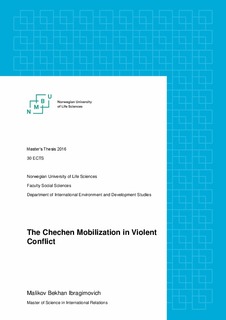| dc.description.abstract | Throughout the centuries, Chechen – Russian relations seem to be of never-ending war and conflict. Although, Chechnya is a tiny territory within huge Russian Federation, still it does not prevent the Chechens to mobilize again and again against Russia. Aiming to understand the reasons of this, this thesis takes a qualitative case study approach in order to understand how the Chechen mobilization was achieved before and during the Second Chechen War in 1999. Kaufman`s theory of Modern Hatreds is the most applicable theory to explain Chechen mobilization. The case study looks at Chechen leaders/elites who invoked the Chechens for violent conflict. The paper also looks at Chechen cultural/social practices since these “frozen elements” are facilitators of Chechen mobilization. Thus, the thesis concludes that the mobilization was achieved due to historical memories (symbols and myths), and manipulation of ethnic fears/emotions by elites. In addition to the symbolic politics, the Chechen social practices were complementary elements that promoted the Chechen mobilization. | nb_NO |
